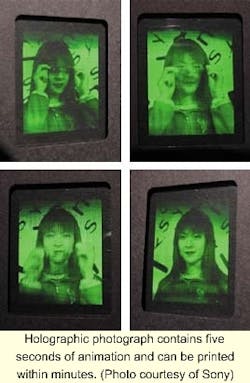Instant printer makes holographic animations
THREE-DIMENSIONAL IMAGING
Incorporating news from O plus E magazine, Tokyo
TOKYOSony Corp. has developed a holographic printing technology that can quickly put several hundred frames of moving image data into one photograph. When the photograph is observed while gradually tilting the paper in the sideways direction, an animated three-dimensional (3-D) image can be seen (see figure). For a photo of 8-cm height and 6-cm width, there are 295 vertical slit-shaped areas in the holographic film. The information for the moving image frames is separated and stored in each of these slits.
Because the image is viewed by reflection of external light, the duration of the animation that can be viewed is dependent on the external light conditions. Using incandescent white light as the external light source, an animation of about five seconds (30 frames/s) can be recorded in one photograph. By using this printing technology, high-quality 3-D images can be easily created using motion picture data. No special recording facilities or skills are required.
The theory involves using a direct-method holographic stereogram where the parallax is only in the parallel direction. The image is created by splitting the image into vertical slit-shaped component holograms, and then exposing them in order. Each component hologram is collected in the left-right direction (parallax direction) by using a cylindrical lens to focus the transmitted light from the image (which is projected by a liquid-crystal display). The up-down direction (non-parallax) is recorded by projecting the image in a slitlike shape and letting it interfere with an incident light source.
As a result, each component hologram has a two-dimensional image recorded in it. But because there is appropriate parallax information in each image that is exposed onto the component hologram, the entire photograph looks like a 3-D image having horizontal parallax.
The projected image is processed using parallax information accumulated by observing the object from different directions. In this study, the parallax image was formed by moving a single camera. By using specialized apparatus, the image processing time could be reduced to less than 0.2 s. Standard software using a workstation requires about 1.8 s. The total processing time to expose a single-component hologram is 0.5 s.
This system not only has an optical system for exposing volume-type one-step holographic stereograms, but it also has real-time perspective processing circuitry. When using a photopolymeric light-sensitive material, the printing time is about three minutes for a photograph with several hundred parallax images, each of 480 x 640 resolution. The technique makes it possible to visualize data that is abstract or otherwise hard to seefor example, computer-aided design or medical images. Wider applications, such as in computer graphics art, are also possible. In addition, by combining this printing technology with 3-D image input devices, it is possible to create instant holographic images of real objects.
Sony has developed a fully automated printer system that acquires and prints a 3-D image in less than three minutes. The company will soon put into place a test service that accepts personal data and prints 3-D still or moving images. Because the holographic photographs are very difficult to replicate, the technique holds promise for authentication of documents.
Courtesy O plus E magazine, Tokyo

